
Manorá is a barrio (neighbourhood) of Asunción, the capital of Paraguay. It has a population of 1,898 people.
The Manora Cantonment is a cantonment town in a small Manora Island, located just south of Karachi, in Sindh, Pakistan. It serves as a military base and residential establishment. It was established by the British Indian Army in 19th-century British India, and taken over by the Pakistan Army in 1947. The cantonment maintains its own infrastructure of water supply, electricity and is outside the jurisdiction of City District Government of Karachi.
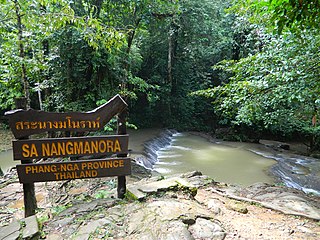
Sa Nang Manora is a forest park in southern Thailand. It covers an area of 0.29 km2 of the Khao Thoi-Nang Hong Forest, Nop Pring Sub-district, Mueang District, Phang Nga Province, about four km north of Phang Nga town. It was established on 15 September 1980.
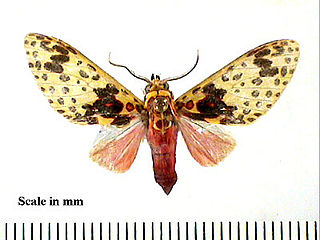
Amaxia is a genus of moths in the family Erebidae erected by Francis Walker in 1855. The type species of the genus is Amaxia pardalisWalker, 1855.
Elysius is a genus of moths in the family Erebidae. The genus was erected by Francis Walker in 1855.

Gymnelia is a genus of moths in the subfamily Arctiinae. The genus was erected by Francis Walker in 1854.
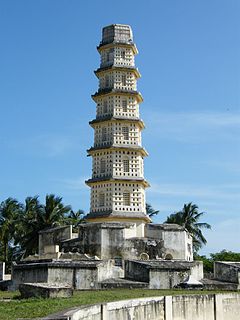
The Manora fort is situated 20 km (12 mi) away from Pattukkottai, Tamil Nadu, India and 60 km (37 mi) away from Thanjavur. The fort was built by Maratha ruler Serfoji II in 1814–1815 to commemorate the successful advance of the British over Napoléon Bonaparte. It is an eight-storeyed, hexagonal tower, which is 23 m high overlooking the Bay of Bengal. The fort derives its name Manora, from the word Minaret.
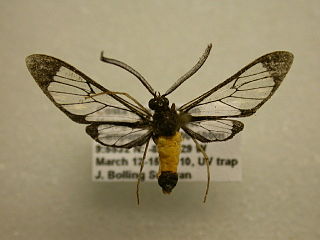
Mesothen is a genus of moths in the subfamily Arctiinae. The genus was erected by George Hampson in 1898.
Saurita is a genus of moths in the subfamily Arctiinae. The genus was erected by Gottlieb August Wilhelm Herrich-Schäffer in 1855.

Aulacodes is a genus of moths of the family Crambidae. The genus was first described by Achille Guenée in 1854.

Xylophanes is a genus of moths in the family Sphingidae erected by Jacob Hübner in 1819. As of 2000, there are about 96 species and subspecies included in the genus.
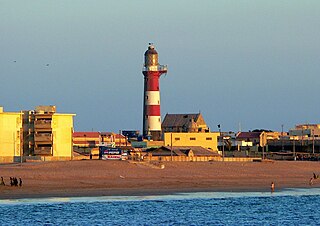
Manora or Manoro is a small peninsula (2.5 km²) located just south of the Port of Karachi, Sindh, Pakistan. Manora is connected to the mainland by a 12 kilometer long causeway called the Sandspit. Manora and neighboring islands form a protective barrier between Karachi Harbour to the north and the Arabian Sea to the south. The western bay of the harbor contains endangered mangrove forests which border the Sandspit and Manora island. To the east is Karachi Bay and the beach towns of Kiamari and Clifton. Overlooking the peninsula is the Manora Point Lighthouse.

Desmia is a genus of moths of the family Crambidae. The genus was erected by John O. Westwood in 1832.

Amaxia chaon is a moth of the family Erebidae. It was described by Herbert Druce in 1883. It is found in Ecuador and French Guiana.
Amaxia pandama is a moth of the family Erebidae. It was described by Herbert Druce in 1893. It is found in Ecuador, Bolivia and the Brazilian state of Amazonas.
Amaxia perapyga is a moth of the family Erebidae. It was described by Walter Rothschild in 1922. It is found in Brazil.
Amaxia theon is a moth of the family Erebidae. It was described by Herbert Druce in 1900. It is found in French Guiana, Venezuela, Ecuador, Peru and Bolivia.

Manora Fort, also known as Debal Fort, was built to protect the harbour of Karachi. Manora is a small peninsula (2.5 km²) located just south of the Port of Karachi. The fort was captured by the British in 1839 - after which they seized control of Karachi.
The Shulamite, also known as The Folly of Desire, a 1915 British silent drama film directed by George Loane Tucker and starring Norman McKinnel, Manora Thew and Gerald Ames. It is based on the 1906 play of the same name by Edward Knoblock.











